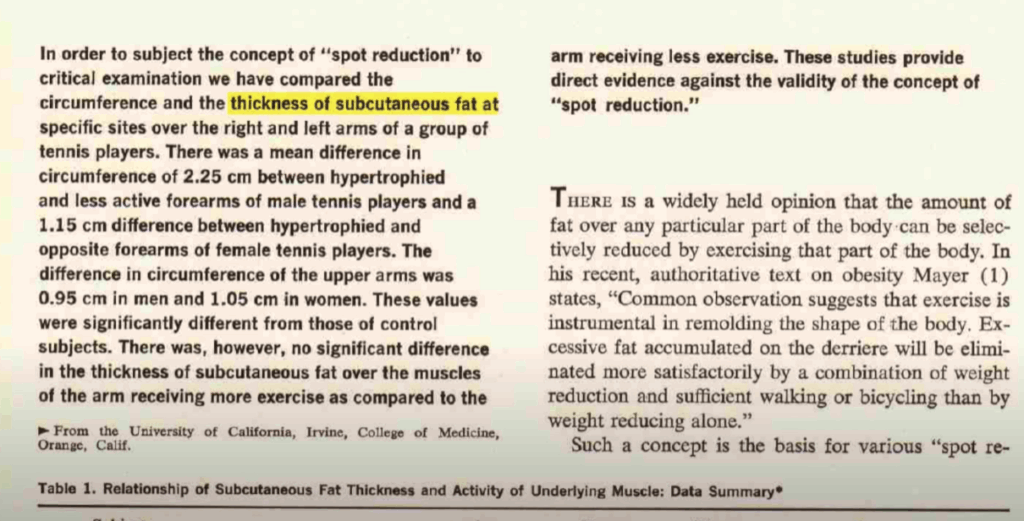It’s one of the most persistent myths in the fitness world: the idea that you can burn fat from specific body parts by training the surrounding muscles—commonly known as spot reduction or targeted fat loss. Whether it’s doing endless crunches to trim the belly or high-rep tricep exercises to tone the backs of your arms, the belief has spread far and wide. But does the science back it up?
Let’s take a closer look at the evidence behind spot reduction, what actually happens during fat loss, and whether any modern techniques might offer a strategic advantage.

The Physiology Behind Fat Loss
Before jumping into studies, it’s important to understand how fat is mobilized during exercise.
Body fat is stored in the form of triglycerides inside fat cells (adipocytes). When your body needs energy, those triglycerides are broken down into glycerol and free fatty acids, which then enter the bloodstream. Once circulating, they can be taken up by muscles and used for fuel.
Here’s the key point: fat burned during exercise doesn’t necessarily come from the body part being trained. The fuel your muscles use comes from the bloodstream, and that blood circulates systemically. So when you’re doing crunches, you’re not necessarily burning fat from your abdomen—your body pulls from fat stores all over.
This undermines the core logic behind spot reduction, but what does the research actually show?
What the Science Says About Spot Reduction
Study 1: Tennis Players and Arm Fat (1971)
In one of the earliest investigations, researchers compared body fat levels in the dominant and non-dominant arms of tennis players. If exercising a specific muscle group burned nearby fat, the dominant arm (which swings the racket) should’ve had less subcutaneous fat. However, the study found no difference in fat thickness between arms, even though the dominant arm was more muscular.
✅ Conclusion: Training a specific area does not automatically lead to fat loss in that region.
Study 2: Single-Arm Training and MRI (2007)
A more controlled trial took over 100 participants through a 12-week arm training program using only one arm. Exercises included preacher curls and tricep extensions, while body composition was measured via MRI. Despite noticeable strength gains, fat volume remained unchanged between trained and untrained arms.
✅ Conclusion: Even when training one limb intensely, fat loss did not occur locally.
Study 3: Single-Leg Training for 12 Weeks (2013)
This study focused on training one leg with a high-volume resistance program over three months. Unlike the earlier study, this one involved significant fat loss. Yet again, researchers found no difference in fat reduction between the trained and untrained legs.

✅ Conclusion: Even with total fat loss, there was no evidence of localized fat burning.
The Game Changer? A 2021 Study from Italy
In a more recent study that shook the consensus, researchers split participants into two groups: one trained only upper body, and the other only lower body. After their strength training, all participants performed 30 minutes of light cardio—an important detail we’ll return to.
Results showed something unexpected:
- The upper-body group lost more fat in their arms.
- The lower-body group lost more fat in their legs.
- Both groups lost the same total amount of fat overall.
These findings hint at the possibility that increasing blood flow to a body part through resistance training may help mobilize fat in nearby tissue—and that performing cardio immediately afterward may increase the odds of that fat being burned rather than re-stored.
🧠 Scientific Note: When fat enters the bloodstream, it doesn’t necessarily get burned right away. If there’s no demand for it (i.e., if you stop moving), it can be reabsorbed and stored again. But performing steady-state cardio after strength training could provide the needed demand.
Should You Start Training This Way?
Despite the promising results, experts remain cautious. Dr. Eric Helms, one of the leading researchers in the field, emphasized that this was just one study with a small sample size. Until more studies confirm these findings, it’s too early to make strong recommendations based on this alone.
That said, there’s no harm in applying the method—especially if you’re already doing cardio as part of your fat loss plan.
Practical Advice for Fat Loss
Rather than obsessing over exercises that supposedly burn fat in one area, here’s what actually works:
✅ 1. Create a Caloric Deficit
Sustainable fat loss always starts with consuming fewer calories than you burn. Whether you cut calories through diet, increase activity, or a combination of both, a deficit is essential.
✅ 2. Strength Train Regularly
Resistance training preserves muscle mass while dieting and boosts metabolic rate. Compound lifts and full-body routines are highly effective.
✅ 3. Prioritize Protein Intake
Aim for at least 0.8–1 gram of protein per pound of body weight. Protein helps preserve lean muscle, increases satiety, and improves recovery.
✅ 4. Add Low-Intensity Cardio
Cardio, especially steady-state like walking or cycling, can support fat loss without adding excessive recovery demands. If you want to experiment with spot targeting, try doing cardio immediately after training the desired area.
The Truth About Stubborn Fat
Everyone has areas where fat seems to linger longer—whether it’s the belly, hips, thighs, or arms. These “stubborn” zones are typically influenced by genetics and hormones, not lack of effort. In nearly every case I’ve coached, these regions simply take the longest to lean out. Patience and consistency win here.
Forget magic pills or miracle moves. Instead, stay the course with smart training and clean nutrition. Eventually, that last bit of fat will come off—just not in the exact spot or time frame you might want.

Final Thoughts: Is Spot Reduction a Myth or Reality?
As of today, most evidence still leans against the idea of reliable, consistent spot reduction. However, one emerging study suggests there might be some truth to it—under specific conditions that involve targeted training followed by cardio.
Until more data confirms this, the most effective strategy remains the basics: create a deficit, lift weights, eat enough protein, and be consistent. Any localized fat-burning effect from targeted work is likely minor compared to these core pillars of body recomposition.



